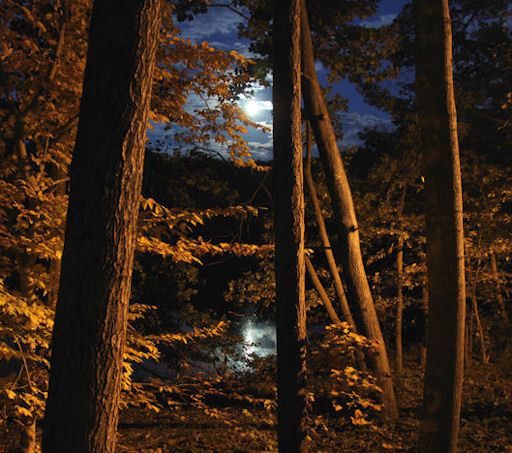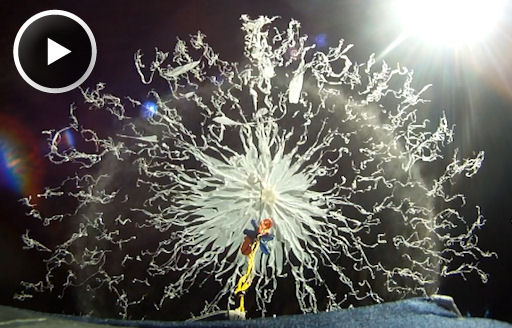Turn your cell phone into a field-tested satellite tracker. Works for Android and iPhone. | | |
RUMBLINGS: A new unnumbered sunspot near the sun's eastern limb is crackling with C-class solar flares. If the sunspot continues to grow, it could soon produce even stronger M-flares and bring an end to this week's lull in solar activity.
HUNTER'S MOON: According to folklore, this week's full Moon is the Hunter's Moon. It gets its name from Native American hunters who once tracked and killed their prey by autumn moonlight, stockpiling food for the winter ahead. Last night, photographer Aaron Top caught the Hunter's Moon beaming through trees around Owen Sound, Ontario:

"The water was so calm that I saw a perfectly-cast moon reflection," says Top. "It was a beautiful sight."
The view gets even better tonight as the Moon approaches Jupiter for a close encounter. On Oct. 12th and 13th it will be possible to hide the lunar disk and the bright planet together behind the palm of your outstretched hand. The conjunction is visible throughout the night; just look for the Moon and you will find Jupiter not far away. [sky maps: Oct. 12, 13]
Hunter's moonshots: from Chris Kotsiopoulos of Attiki, Greece; from John Stetson of Cape Elizabeth, Maine; from Olivier Staiger of Crans-Montana, Switzerland; from Stefano De Rosa of Candia Lake (Turin); from Adrian New of San Antonio, Texas; from Louis Suarato of Schaghticoke, NY; from Jim Saueressig II of Burlington, Ks; from Charles Robinson of Pine Mountain Club, California; from P-M Hedén of Vallentuna, Sweden; from Kevin Jung of Grand Rapids, Michigan;
DRACONID METEOR BALLOON: During the peak of the Draconid meteor shower on Oct. 8th, a group of students in Bishop, California, flew a helium balloon to the stratosphere to try to record some Draconid fireballs in the darkness at high-altitude. Five cameras recorded more than 50 GB of data, which the team is sifting through now for evidence of meteors. While we're waiting for the meteor count, the team offers this video of the balloon popping about 100,000 feet above Earth:

Video: realtime, slow motion. Credit: Earth to Sky, copyright 2011, all rights reserved
Note the ghostly halo around the center of the exploding balloon. That's probably the fine talcum-like powder added by the manufacturer to keep the balloon from sticking to itself. Here is the explosion again in slow motion. Be sure to turn up the volume to hear the sound of the balloon popping. The delay proves that light is faster than sound even in the stratosphere.
The balloon pops by design when it reaches the apex of the flight. Immediately, the payload plummets Earthward, falling several hundred mph through the vanishingly thin air of the stratosphere. To arrest the fall, a parachute opens and delivers the payload gently to Earth about 25 minutes later. The Draconid payload landed in the rugged but beautiful Inyo mountains of central California where it was recovered by the team on Oct. 9th.
more images: Owens River, Snowy Sierras; hi-res pop sequence: #1, #2, #3, #4, #5

